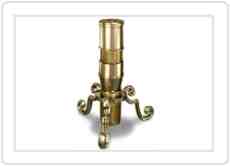History of Microscopes
Circa 1000AD - The first vision aid was invented (inventor unknown) called a reading stone. It was a glass sphere that magnified when laid on top of reading materials.
Circa 1284 - Italian, Salvino D'Armate is credited with inventing the first wearable eye glasses.
1590 - Two Dutch eye glass makers, Zaccharias Janssen and son Hans Janssen experimented with multiple lenses placed in a tube. The Janssens observed that viewed objects in front of the tube appeared greatly enlarged, creating both the forerunner of the compound microscope and the telescope.
1624 - Galileo had perfected a compound microscope.
1665 - English physicist, Robert Hooke looked at a sliver of cork through a microscope lens and noticed some "pores" or "cells" in it.
1674 - Anton van Leeuwenhoek built a simple microscope with only one lens to examine blood, yeast, insects and many other tiny objects. Leeuwenhoek was the first person to describe bacteria, and he invented new methods for grinding and polishing microscope lenses that allowed for curvatures providing magnifications of up to 270 diameters, the best available lenses at that time.
18th century - Technical innovations improved microscopes, leading to microscopy becoming popular among scientists. Lenses combining two types of glass reduced the "chromatic effect" the disturbing halos resulting from differences in refraction of light.
1830 - Joseph Jackson Lister reduces spherical aberration or the "chromatic effect" by showing that several weak lenses used together at certain distances gave good magnification without blurring the image. This was the prototype for the compound microscope.
1872 - Ernst Abbe, then research director of the Zeiss Optical Works, wrote a mathematical formula called the "Abbe Sine Condition". His formula provided calculations that allowed for the maximum resolution in microscopes possible.
1903 - Richard Zsigmondy developed the ultramicroscope that could study objects below the wavelength of light. He won the Nobel Prize in Chemistry in 1925.
1932 - Frits Zernike invented the phase-contrast microscope that allowed for the study of colorless and transparent biological materials for which he won the Nobel Prize in Physics in 1953.
1931 - Ernst Ruska co-invented the electron microscope for which he won the Nobel Prize in Physics in 1986. An electron microscope depends on electrons rather than light to view an object, electrons are speeded up in a vacuum until their wavelength is extremely short, only one hundred-thousandth that of white light. Electron microscopes make it possible to view objects as small as the diameter of an atom.
1981 - Gerd Binnig and Heinrich Rohrer invented the scanning tunneling microscope that gives three-dimensional images of objects down to the atomic level. Binnig and Rohrer won the Nobel Prize in Physics in 1986. The powerful scanning tunneling microscope is the strongest microscope to date.
